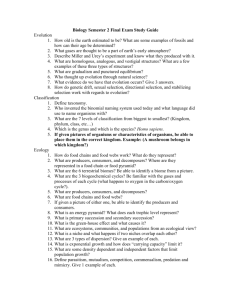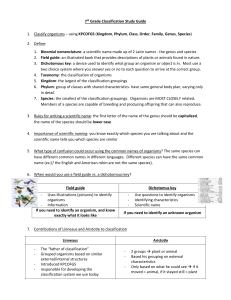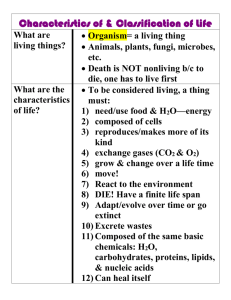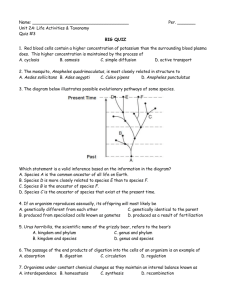TOPIC: Classification AIM: What is classification?
advertisement
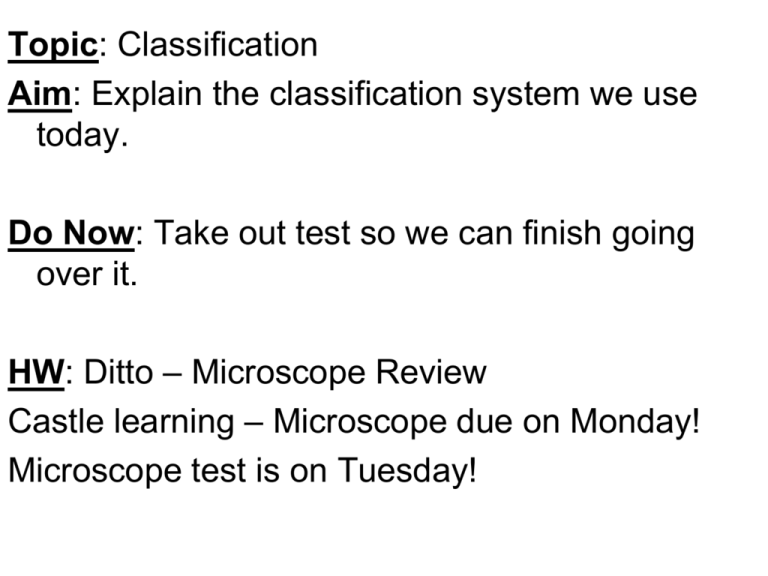
Topic: Classification Aim: Explain the classification system we use today. Do Now: Take out test so we can finish going over it. HW: Ditto – Microscope Review Castle learning – Microscope due on Monday! Microscope test is on Tuesday! Describe one way all students in this class can be separated into groups, or classified. Aristotle (384BC-322BC) developed the first classification system, which divided all known organisms into two groups: PLANTS and ANIMALS. Aristotle then divided each of these main groups into 3smaller groups. Animal Subgroups: Land, Water, Air Plant Subgroups: Small, Medium, Large Scientists have identified more than 2.5 million different organisms. And their job isn’t even close to being finished! Some biologists estimate that there may be at least 7 million different kinds of organisms living in tropical rain forests and in the depths of Earth’s oceans. No wonder why we need to classify! Classification • Grouping of different types of organisms based on similar characteristics Taxonomy • Branch of biology that deals with classification of living things Carolus Linnaeus (1707-1778) like Aristotle, classified organisms according to their traits. The classification systems of both Aristotle and Linnaeus started with the same two groups: Plants and Animals. Linnaeus called these groups kingdoms. But, unlike Aristotle, Linnaeus divided kingdom into 5 levels. Organisms were placed in these levels based on traits, including similarities of body parts , physical form such as size, shape, and methods of getting food. What classification • Carolus Linnaeus system do we use? (1700’s) • All organisms are divided into 7 levels of classification •Largest group Kingdom •Very diverse Phylum Class Order Family Genus Smallest groups and most closely related to Species each other Kings Play Chess On Fine Green Stools Species • One kind of organism that can mate with each other & produce fertile offspring Kingdom Phylum Phylum Phylum Phylum Phylum Phylum Topic: Classification Aim: Explain the method we use today for naimg organisms. Do Now: How similar are two organisms in the same species? HW: Read pages 23-26 in your textbook. Write down the 10 most important concepts you read. Every statement must be in complete sentences. Naming organisms Before Linnaeus developed his naming system, plants and animals were named by a series of Latin words that described the physical appearance of the organism. This was very confusing. For example, let’s look at the first name of the honey bee. Apis pubescens, thorace subgriseo, abdomine fusco, pedibus posticis glabris utrinque margine ciliatus. This means “fuzzy bee, light gray middle, brown body, smooth hind legs that have a small bag edged with tiny hairs.” Linnaeus named it Apis mellifera which means “honeybearing bee.” • Method used to name Binomial organisms Nomenclature • Devised by Carolus Linnaeus • 2 names – Genus species Humans = Homo sapiens Kingdom Animalia Phylum Chordata Class Mammal Order Primate Family Homoide Genus Homo Species sapiens Kingdom Phylum Animalia Cordata Class Order Family Genus Species Mammalia Carnivora Canidae Canis Lupus (the wolf) Canis lupus Dichotomous Key • Detailed list of characteristics used to identify an organism • Arranged in steps with 2 descriptive statements at each step Topic: Classification Aim: To practice using a dichotomous key. Do Now: 1. Explain the difference between passive and active transport. 2. Explain the difference between aerobic and anaerobic respiration. HW: Finish the Dichotomous Key. C6H12O6 alcohol + CO2 + energy C6H12O6 + O2 CO2 + H2O energy C6H12O6 lactic acid + energy The life function of transport in an organism directly involves those activities used to: 1.absorb and distribute materials 2.obtain and break down materials 3.release energy from food 4.produce cellular waste products During a 15-minute exercise period, Phil did push-ups in four 2minute trials (A-D). The graph shows how many push-ups Phil did in each trial. The build-up of lactic acid in Phil's muscle tissue was greatest during trial 1) A 2) B 3) C 4) D The molecules are moving out of the cells, as indicated by the arrows. The # of dots inside and outside of the 2 cells represents the relative concentrations of the molecules inside and outside of the cells ATP is being used to move the molecules out of the cell by 1.cell A, only 2.cell B, only 3.both cell A and cell B 4.neither cell A nor cell B A student squeezes a clothespin as rapidly as possible for one minute. Without stopping to rest, the student continues to squeeze the clothespin for a second minute. At the end of the second minute, the student’s fingers and hand feel very cramped and tired. The physical tiredness and cramping in the muscles in the student’s hand were most likely due to the increased production of 1. ATP 2. waste products 3. oxygen 4. glucose Which statement best describes the general direction of diffusion across the membrane of this cell? 1.Glucose would diffuse into the cell. 2.Protein would diffuse out of the cell. 3.Carbon dioxide would diffuse out of the cell. 4.Oxygen would diffuse into the cell. Review: 1. Which of the following places the seven major classification groups in order from largest to smallest? (1.) phylum, class, kingdom, order, family, genus, species (2.) kingdom, phylum, class, order, family, genus, species (3.) kingdom, phylum, order, family, class, genus, species (4.) genus, species, class, order, kingdom, family, phylum 2. The scientific name for a lion is Panthera Leo. The word Panthera tells us the lion’s (1.) kingdom (2.) phylum (3.) genus (4.) species 3. Members of a population of gray squirrels, Sciurus carolinensis, are classified in the same species because they (1.) obtain their food in the same manner (2.) produce enzymes by synthesis (3.) can mate and produce fertile offspring (4.) live in the same area 4. In today’s classification system, 2 organisms would be most closely related if they were classified in the same (1.) kingdom (2.) phylum (3.)genus (4.)species 5. Which classification category contains the greatest number of different types of organisms? (1.) kingdom (2.) phylum (3.) genus (4.) species Let’s summarize… 1. How are organisms classified in the classification system used today? 2. Explain the difference between a kingdom and a species. 3. Explain the method used for naming organisms. 4. In a dichotomous key, how many descriptive statements are found in each step? 5. When starting a dichotomous key, which step do you start with? 6. What do you do if the first statement is false? Dolphin Tursiops truncatus Raccoon Procyon lotor Fruit flyDrosophila melanogaster



